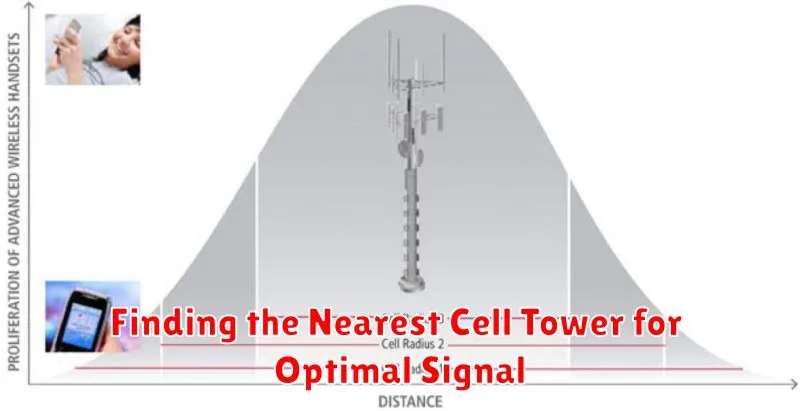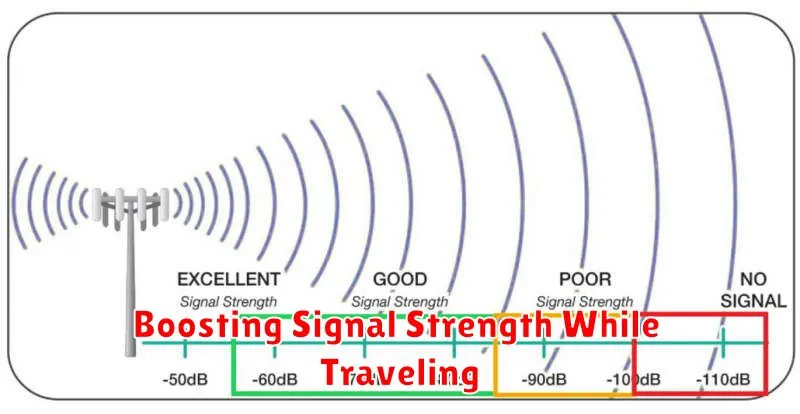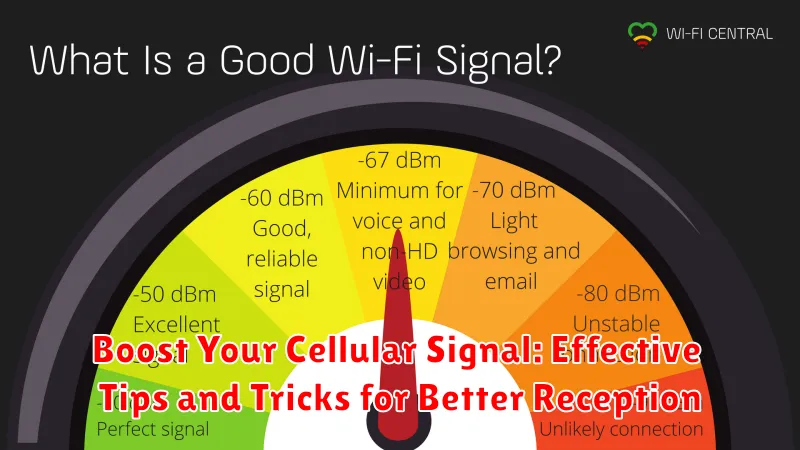Are you constantly battling dropped calls, slow data speeds, and spotty cellular service? A weak cellular signal can be incredibly frustrating, impacting your ability to stay connected and productive. This article explores the various factors that can contribute to poor cellular reception, offering effective tips and tricks to boost your cellular signal and improve your overall mobile experience. Learn how to identify the source of your weak signal and discover practical solutions to achieve better reception whether you’re at home, in the office, or on the go.
From simple adjustments to your phone’s settings to exploring signal boosters and other advanced solutions, we’ll provide actionable advice to help you regain control over your cellular signal. Say goodbye to frustrating interruptions and hello to clear calls, fast downloads, and reliable connectivity. This comprehensive guide will empower you to troubleshoot and resolve cellular reception issues, ensuring a seamless and uninterrupted mobile experience regardless of your location. Discover how to boost your cellular signal and enjoy the benefits of a strong and reliable connection.
Understanding Cellular Signal Strength
Cellular signal strength refers to the power of the radio waves emitted by cell towers and received by your phone. It’s measured in decibels milliwatts (dBm), a logarithmic unit. A higher dBm value (closer to zero) indicates a stronger signal, while a lower dBm value (further from zero, such as -110 dBm) signifies a weaker signal.
Your phone displays signal strength with bars, dots, or other visual indicators. These indicators provide a simplified representation of the actual signal strength. While more bars generally suggest a stronger signal, the exact correlation between bars and dBm can vary by device and carrier.
Signal strength directly impacts call quality, data speeds, and overall connectivity. A strong signal ensures clear calls, fast downloads, and stable connections. Conversely, a weak signal can lead to dropped calls, slow data speeds, and difficulty connecting to the network.
Factors Affecting Phone Signal
Several factors can significantly influence the strength of your cellular signal. Understanding these factors can help you troubleshoot and improve your reception.
Distance from Cell Tower: The further you are from a cell tower, the weaker your signal will be. Signal strength diminishes with distance, especially in areas with obstacles.
Obstacles: Physical obstructions like buildings, trees, and hills can weaken or block cellular signals. Dense urban areas and mountainous regions often experience reduced signal strength due to these barriers.
Weather: Severe weather conditions, including heavy rain, snow, and thunderstorms, can disrupt cellular signals. Atmospheric interference and cloud cover can impact signal propagation.
Building Materials: Certain building materials, such as metal and concrete, can interfere with cellular signals. Being inside a building constructed with these materials can significantly weaken your reception.
Network Congestion: High network traffic during peak hours or special events can lead to reduced signal strength and slower data speeds. When many users are connected to the same cell tower, the available bandwidth is shared, potentially weakening the signal for individual users.
Troubleshooting Weak Signal Issues
Experiencing a consistently weak cellular signal can be frustrating. Before contacting your carrier, try these troubleshooting steps to potentially resolve the issue yourself.
Check Your Phone’s Airplane Mode
Ensure airplane mode is off. Inadvertently enabling it will disconnect you from the cellular network. Toggle it off and check if your signal improves.
Restart Your Device
A simple restart can often resolve temporary software glitches that might be affecting your signal. Power off your phone completely, wait a few seconds, and then power it back on.
Check for Physical Obstructions
Large buildings, mountains, or even dense foliage can obstruct cellular signals. If possible, try moving to a location with fewer obstructions, especially if you’re indoors.
Remove Your Phone Case
While rare, some phone cases, especially metal ones, can interfere with signal reception. Temporarily remove your case to see if it makes a difference.
Check Your SIM Card
A poorly seated or damaged SIM card can cause connectivity problems. Carefully remove and reinsert your SIM card, ensuring it’s properly placed in the slot.
Using Wi-Fi Calling for Better Call Quality
When your cellular signal is weak or nonexistent, Wi-Fi calling can be a lifesaver for making and receiving calls. It allows your phone to use a Wi-Fi network for calls, bypassing the need for a strong cellular connection. This can significantly improve call quality, especially in areas with poor reception, such as inside buildings or in rural locations.
Enabling Wi-Fi calling is usually straightforward. Most smartphones have this feature built-in. You can typically find it in your phone’s settings menu, often under “Connections” or “Network & internet.” The specific steps may vary slightly depending on your phone’s operating system and manufacturer. Once enabled, your phone will automatically use Wi-Fi for calls when a cellular connection is weak or unavailable.
Important Considerations: While Wi-Fi calling offers substantial benefits, be aware of potential limitations. Call quality depends on the strength and stability of your Wi-Fi network. Additionally, some carriers may charge for Wi-Fi calls, especially international calls, so it’s always best to check with your provider.
Finding the Nearest Cell Tower for Optimal Signal

Locating the nearest cell tower can sometimes be helpful in understanding your signal strength. Generally, the closer you are to a tower, the stronger your signal should be, barring any obstructions. There are various methods for pinpointing cell tower locations.
Cell Tower Locator Apps: Numerous apps are available for both Android and iOS devices that specialize in identifying nearby cell towers. These apps often display tower locations on a map, along with information about the carrier and signal type.
OpenSignal: This popular app not only helps you find nearby towers, it also crowdsources signal data, offering valuable insights into coverage quality in your area.
Carrier Websites: Some carriers provide coverage maps on their websites, which can indirectly indicate tower locations. These maps visually represent signal strength across different areas, and clusters of strong signal often correspond to tower locations.
Field Test Mode (Smartphones): Many smartphones have a field test mode that displays detailed signal information, including data that may help you infer the direction of the nearest tower. Accessing this mode varies depending on your phone’s operating system and manufacturer.
Checking for Network Outages in Your Area
Sometimes, a weak or absent signal isn’t due to problems with your phone or home environment. It could be a network outage affecting your area. Checking for outages is a crucial step in troubleshooting your cellular connectivity.
Most cellular carriers offer online tools or apps to check for outages. Visit your carrier’s website or open their app to access their outage map or reporting system. These tools typically show areas experiencing service disruptions and provide estimated restoration times. You can also use third-party websites or apps that aggregate outage information from multiple carriers.
If an outage is confirmed in your area, patience is key. Your carrier will be working to resolve the issue. Check for updates periodically through their online resources or contact their customer support for more information.
Tips for Improving Signal Strength at Home
Several strategies can be employed to enhance cellular reception within your home. Identify areas with the strongest signal. Walk around your house with your phone and observe the signal strength indicator. Choose a location near a window or exterior wall for better reception when making calls.
Remove obstructions. Large metal objects, thick walls, and energy-efficient windows can impede cellular signals. Relocating these objects, if possible, may help. Consider using a signal repeater or femtocell (network extender) to amplify the signal within your home. These devices create a mini cell tower using your broadband internet connection.
Keep your phone’s software updated. Carriers often include performance improvements in software updates, which can sometimes address signal-related issues. Ensure your phone’s operating system and carrier settings are up-to-date.
Consider your phone’s case. Some phone cases, particularly those made of metal, can negatively impact signal strength. Try removing your case temporarily to see if it makes a difference.
Boosting Signal Strength While Traveling

Maintaining a reliable cellular connection while traveling can be challenging. Varying terrain, building density, and distance from cell towers all contribute to fluctuating signal strength. Here are some tips to improve your reception on the go.
Consider a portable cell phone signal booster. These compact devices amplify existing signals, providing a more consistent connection in areas with weak coverage. Ensure the booster is compatible with your carrier’s network before purchasing.
Activate airplane mode strategically. Toggling airplane mode on and off forces your phone to search for and connect to the nearest and strongest cell tower, potentially improving your signal. Be aware this will briefly interrupt your service.
Keep your phone charged. Searching for a signal consumes significant battery power, which can further weaken a low battery’s ability to hold a connection. A portable charger is recommended for extended travel.
Check for network coverage maps. Before heading to a new area, research your carrier’s coverage map. This can help you anticipate potential dead zones and plan accordingly.
Contacting Your Carrier for Network Issues
If you’ve tried troubleshooting steps and are still experiencing persistent signal problems, it’s time to contact your cellular carrier. They have access to network information and can provide specific solutions. Before contacting them, gather some information to expedite the process.
Note the specific location(s) where you experience poor signal. Be as precise as possible, mentioning landmarks or addresses. Also, note the duration and frequency of the issue. Has it been happening constantly, intermittently, or only at certain times of day?
Your carrier might ask about your device model to determine if device-specific issues are at play. They can also check for network outages or maintenance in your area. Be prepared to describe the troubleshooting steps you’ve already taken.
Based on the information you provide, your carrier might suggest further troubleshooting, offer solutions, or escalate the issue to their technical team. They can inform you of any planned network improvements or known issues affecting your area. Contacting your carrier is often the most effective way to address persistent signal problems.

